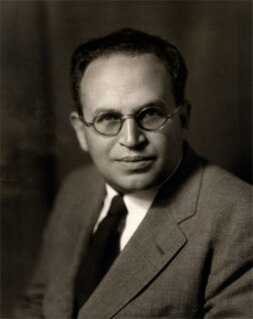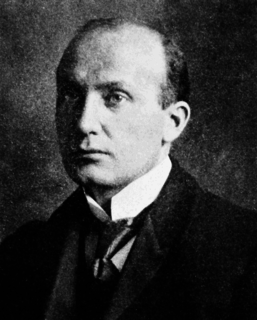Related Research Articles

Lars Valerian Ahlfors was a Finnish mathematician, remembered for his work in the field of Riemann surfaces and his text on complex analysis.

Heinz von Foerster was an Austrian American scientist combining physics and philosophy, and widely attributed as the originator of Second-order cybernetics. He was twice a Guggenheim fellow and also was a fellow of the American Association for the Advancement of Science, 1980. He is well known for his 1960 Doomsday equation formula published in Science predicting future population growth.

Functional magnetic resonance imaging or functional MRI (fMRI) measures brain activity by detecting changes associated with blood flow. This technique relies on the fact that cerebral blood flow and neuronal activation are coupled. When an area of the brain is in use, blood flow to that region also increases.

Jerome Seymour Bruner was an American psychologist who made significant contributions to human cognitive psychology and cognitive learning theory in educational psychology. Bruner was a senior research fellow at the New York University School of Law. He received a B.A. in 1937 from Duke University and a Ph.D. from Harvard University in 1941. He taught and did research at Harvard University, the University of Oxford, and New York University. A Review of General Psychology survey, published in 2002, ranked Bruner as the 28th most cited psychologist of the 20th century.
Experimental psychology refers to work done by those who apply experimental methods to psychological study and the processes that underlie it. Experimental psychologists employ human participants and animal subjects to study a great many topics, including sensation & perception, memory, cognition, learning, motivation, emotion; developmental processes, social psychology, and the neural substrates of all of these.

Paul Felix Lazarsfeld was an Austrian-American sociologist. The founder of Columbia University's Bureau of Applied Social Research, he exerted influence over the techniques and the organization of social research. "It is not so much that he was an American sociologist," one colleague said of him after his death, "as it was that he determined what American sociology would be." Lazarsfeld said that his goal was "to produce Paul Lazarsfelds." The two main accomplishments he is associated with can be analyzed within two lenses of analysis: research institutes, methodology, as well as his research content itself. He was a founding figure in 20th-century empirical sociology

Ernst Heinrich Weber was a German physician who is considered one of the founders of experimental psychology. He was an influential and important figure in the areas of physiology and psychology during his lifetime and beyond. His studies on sensation and touch, along with his emphasis on good experimental techniques gave way to new directions and areas of study for future psychologists, physiologists, and anatomists.

Joseph Leo "Joe" Doob was an American mathematician, specializing in analysis and probability theory.

Jean-Baptiste-Gabriel-Joachim Dausset was a French immunologist born in Toulouse, France. Dausset received the Nobel Prize in Physiology or Medicine in 1980 along with Baruj Benacerraf and George Davis Snell for their discovery and characterisation of the genes making the major histocompatibility complex. Using the money from his Nobel Prize and a grant from the French Television, Dausset founded the Human Polymorphism Study Center (CEPH) in 1984, which was later renamed the Foundation Jean Dausset-CEPH in his honour. He married Rose Mayoral in 1963, with whom he had two children, Henri and Irène. Jean Dausset died on June 6, 2009 in Majorca, Spain, at the age of 92.

Robert Sessions Woodworth was an American academic psychologist of the first half of the twentieth century. A graduate of Harvard and Columbia, he studied under William James along with such prominent psychologists as Leta Stetter Hollingworth, James Rowland Angell, and Edward Thorndike. His textbook Psychology: A study of mental life, which appeared first in 1921, went through many editions and was the first introduction to psychology for generations of undergraduate students. His 1938 textbook of Experimental Psychology was scarcely less influential, especially in the 1954 second edition, written with Harold H. Schlosberg. He is known for introducing the Stimulus-Organism-Response (S-O-R) formula of behavior. A Review of General Psychology survey, published in 2002, ranked Woodworth as the 88th most cited psychologist of the 20th century, tied with John Garcia, James J. Gibson, David Rumelhart, Louis Leon Thurstone, and Margaret Floy Washburn.

Louis J. Ignarro is an American pharmacologist. For demonstrating the signaling properties of nitric oxide, he was co-recipient of the 1998 Nobel Prize in Physiology or Medicine with Robert F. Furchgott and Ferid Murad.
Derek Ashworth Denton is an Australian scientist known for elucidation of the regulation of the electrolyte pattern of the extracellular fluid, the hormones controlling it, particularly aldosterone, and the instinctive behaviours controlling apt intake of water and salts. He was cited in 1995 at election to the National Academy of Science of the United States “as the world’s leading authority on the regulation of salt and water metabolism and relevant endocrine control mechanisms. He is one of Australia’s most eminent scientists with a record of remarkable scholarly and organizational contributions. He is a highly cultured person and internationally recognised for his scientific leadership”.
A baseline in medicine is information found at the beginning of a study or other initial known value which is used for comparison with later data. The concept of a baseline is essential to the daily practice of medicine in order to establish a relative rather than absolute meaning to data. The meaning of baseline in medicine is very similar to that of the running baseline (baseball) being the direct path that a baserunner is taking to the base he is in route to. If the baserunner is outside the 3 foot margin around his running baseline, then he is considered out. Whereas if a patient with kidney failure suddenly has a creatinine of 5.0 mg/dL, then his creatinine is out of his normal. For that person with kidney failure, absolute normal no longer applies because he will never again be able to obtain an absolutely normal creatinine level with kidneys that no longer function properly.
Godfrey Edward Arnold, born as Gottfried Eduard Arnold was an Austrian American professor of medicine and researcher. His studies centered on speech, speech disorder and clinical communicology.
Nazi human experimentation was a series of medical experiments on large numbers of prisoners, including children, by Nazi Germany in its concentration camps in the early to mid 1940s, during World War II and the Holocaust. Chief target populations included Romani, Sinti, ethnic Poles, Soviet POWs, disabled Germans, and Jews from across Europe.

Wolf-Dieter Heiss is an Austrian neuroscientist, Director of the Department of Neurology, University of Cologne and of Department of General Neurology at the Max-Planck-Institute for Neurlogical Research, Cologne (Germany).

James Leonard Corning was an American neurologist, mainly known for his early experiments on neuraxial blockade in New York City.
Dalbir Bindra FRSC was a Canadian neuropsychologist and a professor in the psychology department at McGill University (1949-1980). He is known for his contributions to the neurobiological study of motivation and behaviour and his two books on these topics; Motivation: A Systematic Reinterpretation (1959), and A Theory of Intelligent Behaviour (1976). He also served as chair of the McGill University Psychology Department.
Donald Wayne Seldin was an American nephrologist. He worked at University of Texas Southwestern Medical Center and served as chair of the department of medicine for 36 years.

Charles Richard Taylor was an American biologist whose career focused on animal physiology. After conducting work in east Africa, Taylor became the Charles P. Lyman professor of biology at Harvard University and was named first director the University's Concord Field Station. Taylor was elected to the American National Academy of Sciences in 1985.
References
- ↑ WILDER J (October 1962). "Wilder, J. Basimetric approach (law of initial value) to biological rhythms, Annals of the New York Academy of Sciences, 1962, 98, 1211-1228". Ann. N. Y. Acad. Sci. 98: 1211–20. doi:10.1111/j.1749-6632.1962.tb30629.x. PMID 14000687. S2CID 29512984.
- ↑ Berntson GG; Uchino BN; Cacioppo JT. Origins of baseline variance and the Law of Initial Values. Psycho-physiology 1994; 31(2): 204-10.
- 1 2 Joachim Krauth: Experimental Design. Elsevier/Saunders 2000. ISBN 0-444-50637-3, p. 27